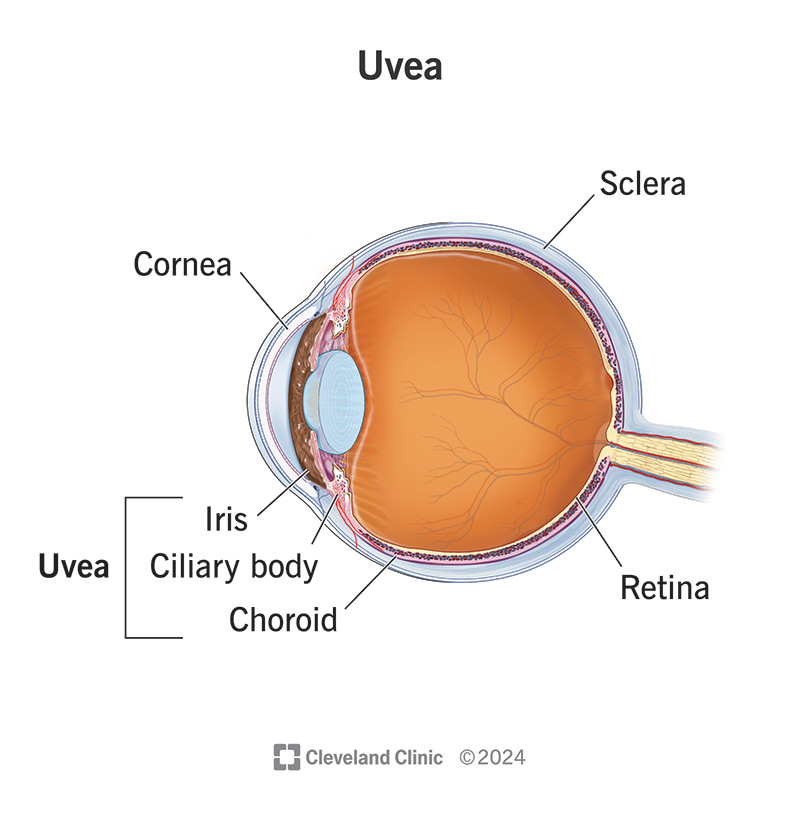Your uvea is a three-part structure that surrounds most of your eye. The three parts of it all play a vital role in eye function. They support surrounding tissues, help control key eye functions and much more. Many conditions can affect the parts of the uvea, but there are also many things you can do to protect the health of this key layer.
Advertisement
Cleveland Clinic is a non-profit academic medical center. Advertising on our site helps support our mission. We do not endorse non-Cleveland Clinic products or services. Policy

The uvea is the middle of three layers that make up your eyes’ outer walls. The term “uvea” comes from words in Latin and Ancient Greek that mean “grape.” That’s because, from the outside, most of the uvea looks like the outside of a grape.
Advertisement
Cleveland Clinic is a non-profit academic medical center. Advertising on our site helps support our mission. We do not endorse non-Cleveland Clinic products or services. Policy
Another name for the uvea is the “vascular tunic.” A tunic is a type of shirt, and “vascular” means “circulation-related.” The uvea wraps around most — but not all — of your eye like a shirt does, and parts of it are packed with blood vessels to provide circulation.
Three distinct parts make up the uvea. These are the:
The different parts of the uvea each have their own jobs.
This is a ring of muscle tissue at the front of your eye, just behind the cornea. It can automatically widen or narrow to control how much light enters your eyes. The iris is also the tissue that gives you your eye color.
This is a ring of tissue just behind the iris. Muscles in it control the shape of the lens of your eye, helping you focus your gaze on objects around you. The ciliary body also makes aqueous humor fluid, a liquid that fills part of your eye and helps your eye hold its globe-like shape.
This is a thin sheet of tissue packed with blood vessels. It’s the largest part of the uvea, wrapping around the central and rear-most sections of your eyeball. It’s just outside the retina (the inner, light-sensitive tissue layer lining the inside of your eye) and just inside the sclera (the white outer eye layer).
Advertisement
If you think about your eye like a house, then the choroid is like that house’s plumbing. The arteries that supply blood to your eye are like the city water supply leading up to the house. Water from the main pipes enters the house and then branches out to different places like sinks, showers and more. That’s similar to how the choroid supplies blood to various parts of your eye (especially your retinas).
Another important feature of the choroid is its color. The choroid contains a lot of melanin, the pigment that gives your skin and eyes their color. Researchers suspect that the choroid helps with absorbing some of the light that enters your eyes, reducing how much light reflects off the retina inside your eye.
The uvea is vulnerable to several different types of medical conditions. The types of conditions can vary partly because the uvea has multiple parts, each with a different job and makeup.
Conditions that can affect the uvea include (but aren’t limited to) the following:
Symptoms from conditions can vary depending on which part of the uvea they affect. The symptoms can include (but aren’t limited to) the following:
There are many things you can do to protect your uveal health and your eye health in general. Some of the best steps you can take include:
Advertisement
Outside of regular eye exams, you should see an eye care specialist whenever you experience eye symptoms that do the following:
Sudden vision loss (like blurring, clouding or other changes) is always a medical emergency. If you experience it, call 911 (or your local emergency services number) immediately.
The uvea may not get all the glory, but that doesn’t mean it’s any less critical to the way your eye works. This multipart structure is right in the middle — literally and figuratively — of what your eye does. When it works like it should, it’s easy to forget how important it can be. But when something is wrong with your uvea, it can be scary not to know what to expect. Regular eye exams are important for catching eye issues — including ones affecting the uvea — before they can cause symptoms and life disruptions.
Advertisement
Getting an annual eye exam at Cleveland Clinic can help you catch vision problems early and keep your eyes healthy for years to come.

Last reviewed on 07/31/2024.
Learn more about the Health Library and our editorial process.